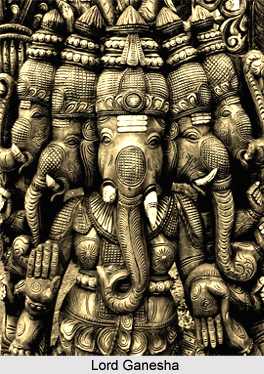 Lord Ganesha is considered as a prominent deity in Jainism. He is the deity of good fortune, new ventures and wisdom by the Jains. The elephant-headed god is worshipped before the commencement of any new venture or rituals and is regarded as the Lord of Beginnings. In Jainism, Lord Ganesha is considered as the arrogant Ganadhara Gautama who disputed to the ideology of the twenty-fourth Tirthankara Lord Mahavira. According to legends, after Lord Mahavira attained enlightenment, he arranged for a Samavasarana. However his voice could not be reverberated in the congregation. Ganadhara Gautama (Indrabhuti Gautama) then appeared there with his pupils. But all his arrogance went away at the divine sight of Lord Mahavira. Ganadhara Gautama became a great devotee of the twenty-fourth Tirthankara. He then composed twelve angas and fourteen Purvas in the form of the Jain texts in a single moment. Ganadhara Gautama is worshipped as Lord Ganesha in Jainism.
Lord Ganesha is considered as a prominent deity in Jainism. He is the deity of good fortune, new ventures and wisdom by the Jains. The elephant-headed god is worshipped before the commencement of any new venture or rituals and is regarded as the Lord of Beginnings. In Jainism, Lord Ganesha is considered as the arrogant Ganadhara Gautama who disputed to the ideology of the twenty-fourth Tirthankara Lord Mahavira. According to legends, after Lord Mahavira attained enlightenment, he arranged for a Samavasarana. However his voice could not be reverberated in the congregation. Ganadhara Gautama (Indrabhuti Gautama) then appeared there with his pupils. But all his arrogance went away at the divine sight of Lord Mahavira. Ganadhara Gautama became a great devotee of the twenty-fourth Tirthankara. He then composed twelve angas and fourteen Purvas in the form of the Jain texts in a single moment. Ganadhara Gautama is worshipped as Lord Ganesha in Jainism.
Lord Ganesha is also worshipped in other forms mentioned in the Jain scriptures. Various sculptures of Lord Ganesha are found in the Jain temples throughout the country. Moreover the sacred swastika symbol is also considered as an auspicious symbol in Jainism. The Jain work of Abhidhanacitamani, composed by Hemachandra, also refers to Ganesha as a Jain deity. The work mentions several forms of Lord Ganesha as Vinayaka, Ganavignesa and Heramba Ganesha. The deity is depicted with the head of an elephant and a pot belly. He carries a battle axe and mounts over a divine mouse.
Acaradinakara of Vardhamanasuri, a Swetambara Jaina work, mentions that Lord Ganesha is worshipped even by the gods to achieve desirable boons. It is also mentioned that the Lord is worshipped before the beginning of any new ceremony or project. The Swetambara community still follows this practice. Acaradinakara also provides the procedures for the proper installation of images of the deity.
However, the Digambara scriptures and sites do not represent Ganesha as a popular deity. Figures of the Lord can be found at Udayagiri and Khandagiri caves in Orissa. The statue of Lord Ganesha with Jaina Yakshi Ambika (Gauri) is the earliest known sculpture of the Lord which dates back to the 9th Century CE. Various images of Lord Ganesha can also found in Jain temples of Gujarat and Rajasthan. Apart from these, idols of the deity can also be found in other ancient Jain temples such as Mahavira at Ghanerav and an 11th century temple in Osian, Rajasthan.




















